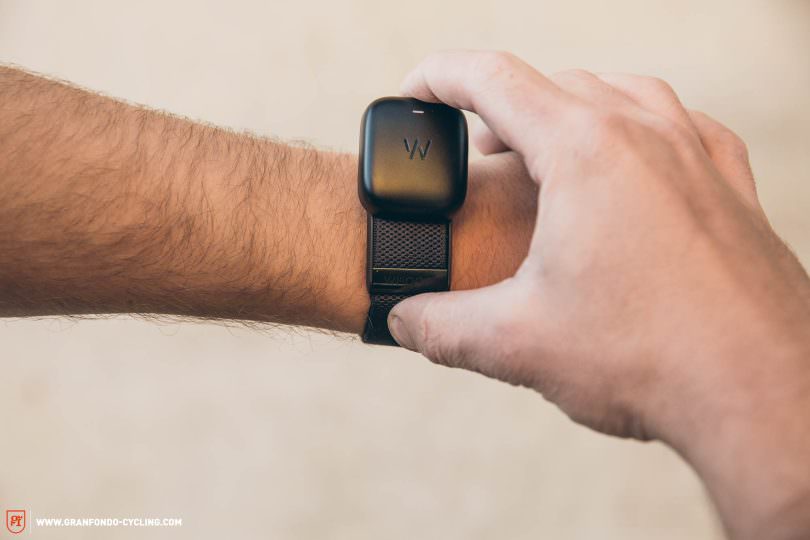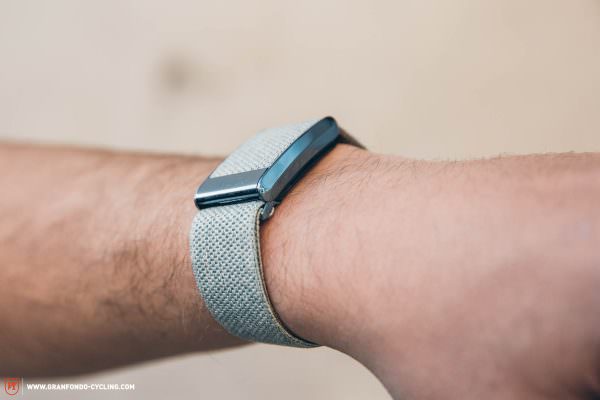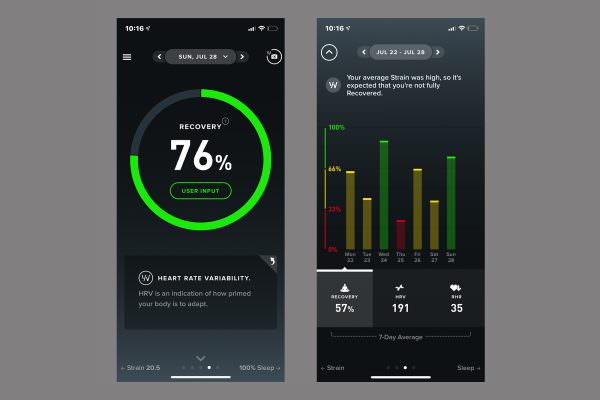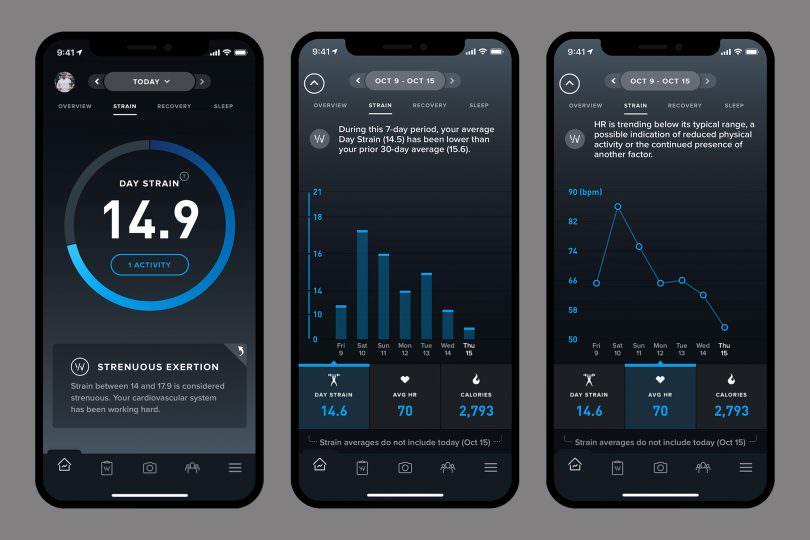WHOOP 4.0 fitness and health tracker long-term review
Leave nothing to chance when training – that’s what the WHOOP 4.0 is designed to do. This device measures recovery and training load around the clock and calculates a value that indicates how much load is optimal for the day or when recovery is called for to avoid overtraining. We tested out how it works.

WHOOP’s mission is to unleash the physical potential that lies dormant in each of us. But to do that effectively, you need to know what’s going on in your body and what condition it’s in. However, according to WHOOP most of us know remarkably little about this – perhaps that’s all the more surprising considering that we can easily analyse and even predict things that happen outside our bodies. WHOOP want to change that with their hardware and software. The WHOOP 4.0 tracker comprises a sensor module that can measure skin temperature, blood oxygen levels and heart rate. It is worn using either a strap on the arm or wrist, or directly on the body with clothing featuring WHOOP’s Any-Wear technology. The software uses numerous algorithms that process the data to be presented in an understandable way in the WHOOP app. The sensor module is included in the monthly subscription cost for the app, which ranges between €18–30 depending on the subscription period. Additional straps for the sensor or clothes from the Any-Wear collection must be purchased separately.
The specs of the WHOOP 4.0 – And what they mean
The WHOOP 4.0 measures skin temperature, blood oxygen and heart rate, with heart rate variability (HRV) determined from the latter. But what does this value tell you? If your heart rate averages 60 bpm, it doesn’t mean that your heart beats exactly once a second. Instead, variability means that some beats will be spaced a little longer and some a little shorter. These deviations are the variability in heart rate and paint a picture of how recovered you are. Low heart rate variability, when the time between heartbeats tends to be very similar, indicates lower levels of recovery than high heart rate variability, because the heart is not able to react as well to changing demands of higher or lower exertion. So if you only look at your resting heart rate to know how recovered your body is, you only know half the truth. The WHOOP 4.0 calculates its three most important parameters from the measurements collected by its sensors: sleep, recovery and exertion. Sleep Coach can determine how long you should sleep to get through the next day, perform well or even deliver peak performances, and the strap around your wrist can wake you up once you’ve had enough sleep. In addition, the app can track your sleep phases and performance i.e. how effective your sleep was and over time, this reveals sleep trends. A good night’s sleep contributes to recovery, which is why WHOOP feeds this into its calculation for recovery together with heart rate variability, resting heart rate and respiratory rate. Recovery is then categorised into three ranges: green means your body is ready for a strenuous day, yellow means your body is ready for moderate exertion and red means your body needs rest. This has a direct influence on the potential load: the better rested you are, the more power your body should be able to produce. The higher the load in a day, the higher the WHOOP Strain level. Based on your recovery, the app provides guidelines on how much load you can tolerate. Through the interaction of these three parameters, it should be possible to exploit the maximum potential of physical performance by giving the body rest when it needs it and then completing the most strenuous training when your body is ready for it.

The battery pack is charged via USB-C and then attached to the strap, which remains on the wrist. This gives the 4.0 model power for up to 5 days and lets you continue recording data while charging.
WHOOP 4.0 for daily training
So much for the theory. How does all this work in practice? We tested WHOOP for six months, starting our test period with the 3.0 model and finishing it with the 4.0. The underlying algorithms need a few days to calibrate to the user, after which they can provide meaningful insight. The strap itself is quite light at 27 g and is hardly noticeable on the wrist when correctly adjusted. Since you’ll never usually take it off, you also get used to it quickly. The battery life holds up for the promised five days and the additional battery pack is finally waterproof and can simply be clipped onto the sensor to charge it fully within about 30 minutes. A firm double tap on the sensor displays the current charge via a coloured LED, though it can sometimes be a little unresponsive. Switching between different straps or attaching the sensor to an Any-Wear garment is quick and easy, though you should always ensure that the sensor sits snugly against your body to ensure the best readings. The wrist-based heart rate measurement, like many other heart rate watches, isn’t always entirely accurate, especially in adverse weather conditions when it’s wet or due to vibrations or movement like you might experience while cycling. Nonetheless, the 4.0 seems to have made progress here compared to its predecessor, though for hard training we recommend wearing the sensor on the body and not the wrist. Despite the heart rate not always being measured accurately, the daily load tallies well with how our experienced testers felt. In turn, the indications provided should be especially useful for newcomers to sport who do not yet have a well-developed sense of their own body and find it difficult to assess stress correctly. For experienced athletes who are planning their training, these metrics become much more interesting in the context of recovery. This metric reveals one or two surprises: if you only rely on resting heart rate to measure recovery and disregard heart rate variability, you run the risk of training too hard. This is where some significant differences emerged, with the WHOOP advising recovery, while a fitness tracker from another brand (which uses only resting heart rate) advising readiness for training. It’s a pity that the strap doesn’t have any display and you can’t see the time or view your current heart rate.

By changing the straps, the WHOOP 4.0 can be easily adapted to your own taste or to the outfit of the day. #mixandmatch

Compared to the WHOOP 3.0 (right), the 4.0 has shrunk significantly, while still offering room for more sensors and longer battery life.
Who is the WHOOP 4.0 for?
Data isn’t much use if it’s not interpreted and understood correctly and the way it’s presented will always have an influence on how it’s understood. That’s why we believe that the athletes who will benefit most from the deep insights WHOOP allows into their bodies are those who follow a structured training plan and already have experience deciphering such data in order to be better able to eke out the maximum training effect or recovery from each day. Here, the WHOOP 4.0 can be a valuable tool for self-optimisation but can also give a professional coach a lot of important information for steering training. Nonetheless, people who mainly want to track their sleep or be warned of potential illness can also benefit from the fitness and health tracker. However, for them the daily suggested load is less relevant and you should remain aware that the information provided can indicate trends but can’t make any absolute statements of truth. At the same time, we should also note that few of us are professional athletes who have time for training all day and can then sleep for nine hours for optimal recovery. We all go full throttle at work to advance our careers and try to combine a few hours of sport with raising our children and our social lives in our free time. It doesn’t help much when WHOOP tells you that you need nine hours of sleep and you know that you have to get up after seven at the latest. At least it’s a reminder that you should keep an eye on your physical and mental balance.

Recovery is calculated from a number of values such as heart rate variability and resting heart rate as a percentage of the maximum recovered state, with the average from the last seven days displayed.

The Sleep Coach tells you how long you should sleep in order to perform optimally the following day. It also analyses how much sleep you actually managed and its cumulative total.

WHOOP 4.0 uses its sensors to determine how much effort was exerted on a given day – the scale goes up to 21 and above 14 is considered strenuous. It also shows the average over seven days and the effect on average heart rate and calories burned.
WHOOP 4.0 conclusion
The WHOOP 4.0 fitness and health tracker gives especially ambitious athletes valuable insights into their own body to optimise training and recovery and to help them reach their full performance potential. It sits securely and inconspicuously on the wrist or can be concealed in the high-quality Any-Wear clothing collection. However, if you don’t follow a structured training plan and do sports primarily for fun, you can skip the WHOOP without any fear of missing out.
Tops
- provides valuable insights into your own body
- very light
- straps can be swapped for different looks
- doesn’t need to be removed for charging
Flops
- wrist-based heart rate measurement not always accurate
- doesn’t replace a watch
Tester: Tobi
Test duration: 6 months
Price: from € 18/month for 18-month subscription
Weight: 27 g
Area of use: sport/everyday
You can find more information about the WHOOP 4.0 fitness and health tracker at whoop.com.
Did you enjoy this article? If so, we would be stoked if you decide to support us with a monthly contribution. By becoming a supporter of GRAN FONDO, you will help secure a sustainable future for high-quality cycling journalism. Click here to learn more.
Words: Tobias Hörsch Photos: Benjamin Topf






